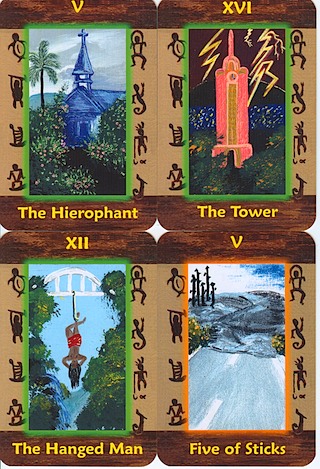By Sheri Harshberger
HazelMoon's Hawaiian Tarot
Self-published by Katalin E. Csikos, http://www.MyHawaiianTarot.com
ISBN: 978-1-61623-636-6
Katalin E. Csikos pays tribute to the Hawaiian culture, past and present, with her newly and self-published HazelMoon's Hawaiian Tarot. The shrink-wrapped box is approximately 6 inches tall by a little over 4 inches wide by a little over an 1.5 inches thick, and accommodates both the deck and a 108-page companion book.
The deck structure follows the classic 78-card Tarot structure with 22 Major Arcana cards and 56 Minor Arcana cards. The Majors are numbered with Roman Numerals and The Fool is 0. Strength is VIII and Justice is XI. The Minors are also numbered with Roman Numerals with the exception of the Courts, which aren't associated with numbers. Most of the card titles of the Majors will be familiar to users of the Waite-Smith deck or clones of it. The 15th card of the Majors, which is traditionally The Devil card is called The Evil in this deck. The Courts in this deck are King, Queen, Warrior and Boy, with Warrior and Boy representing the traditional Knight and Page, respectively. The suits of Wands and Pentacles (or Coins) are represented by Sticks and Lava Stones.
With dimensions of nearly 4.5 inches tall and 3 inches wide, these cards are somewhat shorter and wider than a Waite-Smith deck. The corners are rounded and the cards are flexible so they are comfortable to shuffle, but the cards have a glossy lamination that makes them a bit stiff (which I like). The deck sits much taller than a Waite-Smith deck, which may be due the the lamination or card stock used.
Each card contains an image that is from a painting by the author. The images are contained within a somewhat wide border (larger than .5 inches) that is very interesting in its own right. The top and bottom border sides have a rich, dark woodgrain. The top contains the card number, centered and and printed in yellow. The bottom contains the card title, also centered and printed in yellow. The left and right border sides are gold with four of eight native glyphs on each side. The image on each card is centered and has a glow of color emanating from it into the border (which makes the borders seem smaller than they are). The color of the glow varies. The Majors have a green glow. Sticks are orange, Cups are a cyan blue, Swords are red and Lava Stones are purple. The back of the cards depict an image of palm tree being viewed from the ground up in browns and sepia. The image looks like it is on old paper with worn edges sitting on a brown surface. While the image itself is not reversible, the deck is intended to be used with reversals if the owner wishes, as the author has included reversed meanings for each card in the companion book.
The imagery used in this deck is beautiful and haunting. The colors are striking. Through her paintings, Ms. Csikos brings Hawaiian culture (pre-Caucasian encroachment and post) and Tarot culture together. Looking through the deck, you see the Hawaiian people and their interaction with nature and their integration with the outside world. We see the Hawaiian people, volcanic activity, oceans, tropical foliage, and buildings... all elevated to the same level so conflict and other interaction, feelings, etc., can be depicted by any combination of these things.  In The Hierophant card, the iconic white church is shown no longer white and being overwhelmed by the beautiful native vegetation. The Tower card shows the well-known Aloha Tower in Honolulu. The Hanged Man showing a Hawaiian hanging from a white bridge. In the Five of Sticks card, the conflict shown is between a road and a lava flow. The cards show the history and evolution of the Hawaiian culture and spirit through diversity, with a return back to an eternal spiritual base. There is a melancholia for what has been lost, but also an optimistic and powerful expectation for the future, all shared with a friendliness and openness that the islands have come to be known for.
In The Hierophant card, the iconic white church is shown no longer white and being overwhelmed by the beautiful native vegetation. The Tower card shows the well-known Aloha Tower in Honolulu. The Hanged Man showing a Hawaiian hanging from a white bridge. In the Five of Sticks card, the conflict shown is between a road and a lava flow. The cards show the history and evolution of the Hawaiian culture and spirit through diversity, with a return back to an eternal spiritual base. There is a melancholia for what has been lost, but also an optimistic and powerful expectation for the future, all shared with a friendliness and openness that the islands have come to be known for.
The companion book is well done. I hesitate to call it a "little white book" (LWB) because it is a professionally bound, small paperback book of 103 pages. The first sections introduce the reader to the reasons Ms. Csikos decided to make a Hawaiian Tarot, the spirit of Hawaii, and some information on Tarot in general. Most of the book is dedicated to providing individual card meanings for upright and reversals of the cards, including information on the landmarks depicted or other specific information when relevant. She also includes a Celtic Cross spread.
I'm always excited when Tarots appear that dare to challenge the traditionally European archetypes with archetypes relevant to the culture, people or region the Tarot is created to depict or share. This deck is a great example of this. I would recommend this deck to anyone looking for a deck somewhat outside the traditional Waite-Smith or clone deck.
All images copyrighted(c) by Katalin E. Csikos and used with permission.